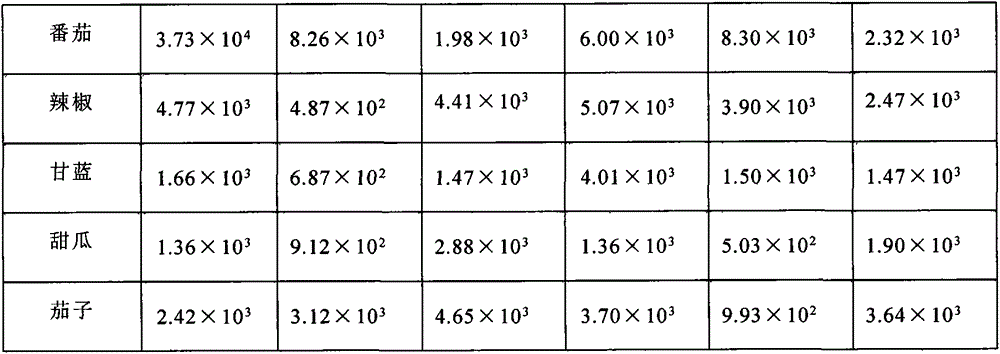Bacillus marinus capable of inducing disease resistance and stress tolerance of plant
A technology of marine bacillus and induced plants, applied in the direction of plant growth regulators, microorganism-based methods, botany equipment and methods, etc., can solve the problems of poor control effect of soil-borne diseases, difficulty in survival, colonization, restrictions, etc., Achieve the effects of stable biological characteristics and pesticide activity, good development prospects, and low production costs
- Summary
- Abstract
- Description
- Claims
- Application Information
AI Technical Summary
Problems solved by technology
Method used
Image
Examples
Embodiment 1
[0015] Embodiment 1: Artificial cultivation and fermentation of CT-2628 bacterial strain
[0016] The preservation number is: CT-2628 strain of CGMCC No.8921, through medium optimization test, beef extract 1-3g, peptone 2-3g, yeast powder 1-3g, glucose 1-3g, NaCl, 20-30g, KCl0 .3-0.5g, MgCl 2 ·7H 2 O1.9-2.5g, FePO 4 0.01-0.02g, water 1000ml, pH7.0-8.0 The above is the culture medium, add agar 16-19g to make the solid medium;
[0017] Cultivated on the above-mentioned solid medium, and tested its physical and chemical characteristics by conventional methods, the characteristics of the strain are as follows: the characteristics of the strain are that the colony is turbid yellow, and the surface is mostly wrinkled, sometimes smooth, and dark blue pigment is produced on the peptone medium in the later stage; the bacterium is rod-shaped, Positive Gram staining 0.6-1.9μm×2.9-5.9μm, no capsule, perinatal flagella, spores, aggregated into chains, hydrolyzed starch, gelatin, catalas...
Embodiment 2
[0019] Embodiment 2: The in vitro antibacterial activity of CT-2628 bacterial strain to various phytopathogenic fungi:
[0020] The fermentation broth adopts conventional confrontation culture method and antibacterial rate statistical method. The target bacteria are 9 kinds of plant pathogenic fungi that are seriously harmful to agricultural production: Pyricularia oryzae, Alternaria solani, Fusarium oxysporum, ash The antibacterial test results of Botrytis cinerea, Verticillium dahliae, Cladosporium fulvum, Phytophthora capsici, and Rhizoctonia solani Fusarium graminearum are shown as follows:
[0021] Table 1 CT-2628 antibacterial activity to plant pathogenic bacteria
[0022]
[0023] Note: Plant pathogenic bacteria: Po: Pyricularia oryzae; As: A』ternaria salani;
[0024] Fo: Fusarium oxysporum: Bc: Botrytis cinerea;
[0025] Vd: Verticillium dahliae; Cf: Cladosporium fulvum;
[0026]Pc: Phytophthora capsici; Rs: Rhizoctonia solani;...
Embodiment 3
[0031] Example 3: Colonization of CT-2628 bacterial strains in living plants
[0032] The methods tested are all routine test methods for plant colonization: after CT-2628 was labeled with rifampicin, the above methods were cultured and fermented, tomato seedlings and cucumber seedlings were immersed in the fermentation broth, and planted in common cultivated soil and coastal saline soil (NaCl content 0.5 %), grind each tissue of the seedlings at 1, 3, 5, 7, 10, and 15 days respectively, take samples and culture them on the plate culture medium added with rifamp, and convert them into the number of bacterial colonies per gram of the sample (cfu / g), the result proves that the cucumber, tomato, capsicum, cabbage, muskmelon, and eggplant of the CT-2628 strain can be colonized normally no matter in common cultivated soil or seashore saline soil, and roots, stems, The highest colonization number of leaves can reach 6.00×10 3 , 8.30×10 3 , 4.65×10 3 , 15 days after treatment, CT-...
PUM
 Login to View More
Login to View More Abstract
Description
Claims
Application Information
 Login to View More
Login to View More - R&D
- Intellectual Property
- Life Sciences
- Materials
- Tech Scout
- Unparalleled Data Quality
- Higher Quality Content
- 60% Fewer Hallucinations
Browse by: Latest US Patents, China's latest patents, Technical Efficacy Thesaurus, Application Domain, Technology Topic, Popular Technical Reports.
© 2025 PatSnap. All rights reserved.Legal|Privacy policy|Modern Slavery Act Transparency Statement|Sitemap|About US| Contact US: help@patsnap.com



